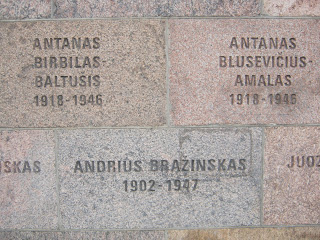Yesterday was a clear and blue sky day -
but today it has snowed all day.
I went out for a walk in the snow -
while Liz read from her kindle and did her foot exercises. The ankle is getting better and better - it's just those rough, icy spots under the snow that are a special pain. But she gets out for walks at least as much as I do.
A couple days ago we went up Gedimino Prospect to one of the museums one has to visit in Vilnius.
I published this photo a few weeks ago, but here it is again: the old KGB headquarters. You may remember the engraved building blocks along the sidewalk -
with the names of some of those killed during the Soviet years.
The building now contains The Museum of Genocide Victims.
Most of the building seems to be given over to offices, but two floors on one side and toward the back, plus part of the basement, contain the museum. A sign near the door says that "between 1940 and 1991 this building housed the representative institutions of the NKVD and KGB" - the Soviet secret police.
The museum opened in 1992 and contains exhibits giving details of life under Soviet occupation. The interior of the building has not really been improved since those times, so the effect is a deep sadness and an awful feeling that no one has cared for the building or for those who came through its doors.
The display follows the historical sequence of events, starting with the first "peaceful" emissaries from Moscow following the Molotov-Ribbentrop Pact and the secret agreements for dividing up eastern Europe and the Baltics into German and Soviet plunder: the arrival of troops and more troops, the Lithuanians who cooperated - and those who didn't - - and the arrests, imprisonments, murders and deportations which followed; the fight of the partisans from the very beginning until the last of them were captured or killed in 1953, and the civil resistance from the beginning until independence in 1991. Some of the dates of those in Soviet prisons and in exile actually go all the way to 1991! That's just yesterday!
There are lots of photos, drawings, paintings, homemade crafts. As more people eventually moved from labor camps into less stringent exile you see photos of aspects of Lithuanian culture and religion that survived and even thrived far from home.
In the basement is the KGB prison; and, after you walk down the long, grim corridor, you go through a small outdoor exercise yard and then, the execution room.
Almost as an afterthought, there is one room on the prison level which holds an exhibit about the years 1941 to 1944 when the occupying power was not the Soviet Union but Nazi Germany, and the building was not KGB but Gestapo headquarters. The persecution of all Lithuanians continued in those years, but the majority of the victims were Lithuanian Jews.
Most of the residents of the small and large ghettos of Vilnius were killed, and, overall, about 95% of Lithuania's Jewish population of almost a quarter of a million were murdered, the highest percentage in Europe.
And the small display in the museum basement acknowledges that many of the killers were local, Lithuanian collaborators.









No comments:
Post a Comment